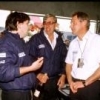Ah, but the plot now thickens. I've been back through the contemporary race reports in Autosport. At the 1969 International Trophy Simon Taylor carefully explained the genesis of the M7C, and that the chassis plate on it read 'M7A/004'. However, at the very next race (Spanish GP) the Autosport race statistics refer to the car as 'M7C-1', and continue to use that designation for the rest of the car's GP career. There must have been a good reason for this ...
What I don't understand why McLarens would have advance paperwork for MT7C-1 and then race the car as M7A-004
Thanks for the chassis number clarification Tim

Still not sure where McLaren put the fuel prior to the side tanks being added by SRO ?
It would be interesting to know what became of M7A/004 / M7C-1 after it's days as part of the Eccurie Bonnier team?
Or why M7A-3 became known (in some places) as an M7B?
Thanking you in anticipation :-)














